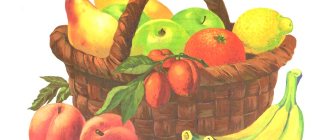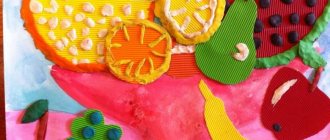"Canning fruit." Summary of a drawing lesson in the second junior group
Kristina Ponurovskaya
“Canning fruit.” Summary of a drawing lesson in the second junior group
Drawing with paints “ Canning fruits ”
.
Continue to develop children's ideas about preparing food for the winter.
Exercise children in drawing round objects and painting over images.
Silhouettes of cans of different sizes cut out of paper (according to the number of children, gouache, brushes. Toy bear, hedgehog, apple, cubes, construction set .
Progress of the lesson:
Act out a scene with the help of a junior teacher : “Toys come to life”
.
A teddy bear climbs onto the table and accidentally drops an apple on the floor.
A toy hedgehog runs up, takes the apple and takes it to its hole.
Doll Masha (teacher)
asks the hedgehog:
- Why are you dragging the apple into the hole?
- Apples don’t grow in winter, but I’ll save them and I’ll have an apple.
“But it will rot,” laughed the doll Katya ( junior teacher )
.- For the winter, if you want to preserve
fruits , you need to make compote.
(The teacher leaves unnoticed by the children)
.
All the sad ones leave.
The teacher invites the children to help with the toys. Hands out jars and offers to fill them with apples.
Shows how to draw and color apples, paying particular attention to the order in which the jars are filled with apples (top to bottom)
.
Before finishing work, the teacher asks the children where the compotes should be stored throughout the winter. After listening to the children's answers, he invites the children to build from building material construction blocks )
a cellar where all these jars of compote could stand.
Children begin to build (in the construction )
.
After construction is completed, the children put their jars of compote in the cellar. Application “Canning vegetables” (complex lesson in the second junior group) Goal: to develop children’s interest in knowledge about vegetables through the integration of educational areas: cognition, artistic creativity.
Tasks:. Summary of OD in the second junior group “Canning vegetables” Goal: to develop children’s interest in knowledge about vegetables through the integration of educational areas: cognitive development, speech development,.
Summary of an open drawing lesson in the second junior group. Theme of the lesson: “Ornamented Christmas tree.” (teamwork). Goal: learn to decorate a Christmas tree using unconventional drawing methods. Objectives: develop.
Summary of an open lesson in the second junior group “Healthy vegetables and fruits” Branch “Akvarelka”, a municipal autonomous preschool educational institution of the municipal formation of the city of Krasnodar “Children's Center.
Summary of an open lesson in the second junior group on play activities “Vegetables and fruits - vitamin products” Topic: “Vegetables and fruits - vitamin products” Purpose: To teach children to differentiate vegetables and fruits Objectives: 1. Expand the active vocabulary of children.
Summary of a drawing lesson in the second junior group “Rain” Objectives: to teach children to rhythmically apply strokes, placing them all over the sheet; to introduce them to a natural phenomenon (rain); to teach them to find similarities.
Summary of a drawing lesson in the second junior group “Autumn Leaves” Summary of a drawing lesson in the 2nd junior group on the topic “Autumn Leaves” Purpose: • Continue to teach how to draw with your palms - dip them in paint.
Summary of a drawing lesson in the second junior group “Balls” Purpose: to teach children to color objects with ready-made contours with pencils. Objectives: 1. Educational: teach to analyze, highlight the main ones.
Summary of a drawing lesson in the second junior group “Where are you, chickens?” Summary of a drawing lesson in the second junior group. Topic of the lesson: “Where are you chickens?” Goal: To introduce children to a new way of drawing.
Source
Summary of a drawing lesson in the second junior group “Compote of fruits and berries”
Irina Safonova
Summary of a drawing lesson in the second junior group “Compote of fruits and berries”
- continue to teach children to form an adjective from a noun; agree in gender between a noun and an adjective;
- consolidate the ability to paint large and small objects without going beyond the outline;
Materials for the lesson :
— Toy bed and doll;
— Cards with fruits and berries ;
— A landscape sheet with a pot of compote and a mug of compote drawn on it ;
— A landscape sheet with drawn on it;
Paint brush , red gouache, jar of water, cloth.
Fruit theme PNG images | Vector and PSD files
- fruit theme orange cartoon illustration
2000 * 2000
- fresh natural fresh banana fruit theme poster
1200 * 1200
- fresh fashion strawberry summer fruit theme poster
1200 * 1200
- Blueberry fresh fruit theme poster
1200 * 1200
- Fresh summer fruits theme poster
1200 * 1200
- Fresh summer fruits theme poster
1200 * 1200
- avocado summer fresh fruit theme poster
1200 * 1200
- fruit theme citron illustration
2050 * 2000
- natural fresh summer pineapple fruit poster
1200 * 1200
- fruit theme banana illustration
2000 * 1999
- fashion fresh simple summer fruit t theme poster
1200 * 1200
- fashion fresh simple summer fruit theme poster
1200 * 1200
- fresh fashion simple watermelon fruit theme poster
1200 * 1200
- fashion simple summer fresh orange fruit theme poster
1200 * 1200
- fashionable simple summer poster with fresh fruit theme
1200 * 1200
- summer fresh fashion simple orange fruit theme poster
1200 * 1200
- fashion fresh simple orange fruit poster
1200 * 1200
- fresh fashion simple summer fruit theme poster
1200 * 1200
- peach fruit pattern
2000 * 2000
- fruit theme with lemon
2000 * 2000
- natural fashion simple summer fresh fruit poster
120 0 * 1200
- fashionable simple fresh summer poster with fresh fruit theme
1200 * 1200
- fruit theme lemon cartoon illustration
2000 * 2000
- red strawberry style summer fresh fruit theme poster
1200 * 1200
- Fruit themed calendar for November
4267 * 5705
- Fire dragon summer fresh fruit theme poster
1200 * 1200
- Fruit theme tomato illustration
2000 * 2000
- vegetable and fruit theme decorative photo paper
1200 * 1200
- modern fashion fresh simple summer watermelon fruit poster
1200 * 1200
- mobile app fruit theme icon design
1024 * 1369
- fruit theme lemon hand drawn illustration
2000 * 2000
- fruit theme co illustration conut
2000 * 2000
- fruit theme banana illustration
2000 * 2000
- modern fashion simple summer fresh fruit theme poster
1200 * 1200
- summer fruit theme poster border
3543 * 5315
- Fashionable vintage poster with banana fruit theme
1200 * 1200
- Creative peach woman fruit theme illustration
2000 * 2000
- Chinese style summer fruit theme border
3543 * 5315
Progress of the lesson:
There is a toy bed with a doll in it.
-The doll Masha got sick. She doesn’t feel well, she has a high temperature, a sore throat, she lies in bed all day, but she so wants to play with the guys, go for a walk. How can we help Masha get better faster? (all children's answers are listened to)
.
Masha's mom asks us to help cook compote , which contains a lot of vitamins.
Want to help mom? Can you do it? Didactic game “In the store”
(there are cards with fruits and berries )
- Guys, let's stretch our fingers before work:
We will cook compote ,
(We hold our left palm with a “bucket”
)
You need a lot of fruits . Here:
(with our right hand we “interfer”
)
Let's chop apples
(We bend the fingers on the right hand, starting with the thumb.)
We will chop the pear,
Squeeze the lemon juice
We'll put in some drainage and sand.
We cook, we cook compote .
Let's treat honest people.
Children sit at tables on which there are sheets of paper with drawn on them.
- What are we going to use to cook the compote ? (in a saucepan)
- Cook a compote from the fruits and berries that you have chosen (children “cook”
the compote )
- Which compote did you cook ?
You?
(talk to each child)
- Would you like to try the compote we cooked? (Yes)
— But the compote is very hot . How can you cool compote ? (stir with a spoon, blow)
Children stir compote and blow.
— The compote has cooled down , you can try it.
Children “drink”
compote .
— Delicious compote ?
Children show with their facial expressions that they like the compote .
3. Summary of the lesson
-Who did you help today? (to mom)
- How did you help her? (made compote for Masha )
The teacher praises the children and says that they were able to help their mother cook compote because they know what fruits and berries it is made from and what color it comes out of. Masha will definitely get better soon, because our compotes contain a lot of vitamins .
Summary of the drawing lesson “Birdhouse” in the second junior group 2 junior group “Alyonushka” Educator Svetlana Vladimirovna Timofeeva Summary of the art activity classes in kindergarten No. 229, Novosibirsk.
Summary of a lesson on speech development in the second junior group “Description of vegetables and fruits” Summary of a lesson on speech development in the second junior group “Description of vegetables and fruits” Purpose: To enrich children’s vocabulary through expansion.
Summary of the drawing lesson “Traffic light” in the second junior group Objectives: 1. To introduce children to the traffic light and its purpose 2. To consolidate knowledge of the primary colors (yellow, red, green) 3. To consolidate.
Summary of the drawing lesson “Rug for a bear” in the second junior group: Purpose: To learn to draw horizontal lines, to consolidate the ability to hold a brush correctly, to consolidate colors: blue and red, to cultivate aesthetics.
Summary of a drawing lesson in the second junior group “Chamomile” Summary of a drawing lesson in the second junior group “Chamomile” Purpose: to learn to convey the image of a flower, its structure and shape using brushes;
Summary of a drawing lesson in the second junior group “The cat has a mustache” Objectives: finishing drawing the cat’s mustache; working with an unfinished composition. Objectives: develop the ability to rhythmically draw short horizontal lines.
Summary of a lesson with children in the second junior group on drawing “Microbes - who are they” “Microbes - who are they” Purpose: to introduce children to the concept of microbes; give an idea of what they are, their benefits and harms.
Lesson notes for the second junior group on the application “Fruit compote” Lesson notes for the second junior group on the application. Teacher Nosova O.V. August Topic: Fruit compote Purpose: To introduce children.
Summary of a drawing lesson in the second junior group “We made snowmen” Drawing lesson in the second junior group We made snowmen Goal: to consolidate children’s knowledge about winter activities, to evoke positive ones.
Source
Drawing lesson Fruits in the middle group of kindergarten
Kindergarten teachers love art lessons. And one of the interesting activities is where children learn to distinguish fruits from vegetables and berries. Sometimes even an adult cannot do this. For example, did you know that a banana is a berry? And children should know. The topic is, of course, difficult, but that’s what makes it interesting. Today we will tell you how to conduct a lesson on drawing fruits in the middle group of kindergarten.
Drawing with watercolors
To interest children, you need to present them with drawing not as an activity, but as an exciting game. Then the child will approach the process creatively. Drawing fruits in the middle group of kindergarten begins with an introductory lecture. The teacher asks the children what their favorite plant-based sweets are. The guys actively take part in the discussion. You can hear options: apples, pears, bananas, strawberries. The teacher shows the pictures and explains which of the above are fruits and which are not. After the theoretical part there should be a practical one. Children are given watercolors, and the teacher tells them how to draw, for example, an apple. It needs to be explained with an example. The teacher draws a fruit and the children copy it. First you need to draw an outline with a pencil. The teacher controls this stage of work. And then the outline should be painted over. The teacher’s task is to prevent children from going beyond the drawn boundaries.
Drawing with gouache
All creativity with paints is somewhat similar. So, drawing fruits in the middle group with gouache is not much different from creativity with watercolors. But it is necessary to change techniques at least so that children can see the difference in paint consistency. Gouache drawings turn out much brighter and more positive. In order not to repeat techniques, the teacher can invite his students to draw a fruit, for example a pear, without a preliminary pencil sketch.
This way the child will develop his eye and will not be afraid to create. After all, parents often discourage the desire to draw because they want to get the perfect result. The child enjoys the process itself.
Draw with your hands
Many people think that painting without a brush is the province of two-year-olds. Adult children need to create with a brush. But that's not true. A child remains a child, and pampering gives him pleasure. Therefore, the teacher may well include in the program the task for the middle group “to draw fruits using fingers and palms.” It is worth understanding that many children have little imagination, and before awakening it, you need to show an example of how to create. Therefore, having rolled up her sleeves, the teacher should be the first to dip her palm in the paint and draw, for example, an orange. Children must repeat this action. And then you can give an imagination task. For example, draw your favorite fruits and berries. Sometimes you can only be surprised how limitless a child's imagination can be.
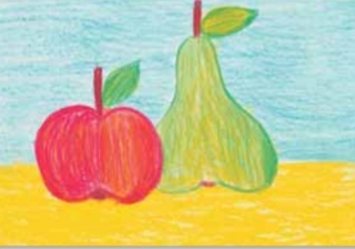
Drawing using the grattage technique
But you shouldn’t give your child watercolors and gouache at every lesson. You can use other, no less interesting techniques. One of these is grattage. Students in the middle group will definitely like the technique. Drawing vegetables and fruits will be more fun if you have to “extract” them from the ground. For this activity, the teacher will need to prepare creativity sheets. By the way, children can also help at this stage. Preparation technology:
- Use colored pencils or crayons to paint over the entire surface of the sheet.
- Lubricate the paper with a thick layer of wax or paraffin.
- Paint the entire sheet with black gouache and let it dry. To prevent the paint from remaining on the pupils’ hands, it is necessary to dilute it with PVA glue before applying it to the paper.
When the preparation is complete, you need to start drawing. You can draw with a pen or a blunt pencil. The object should be sharp enough to scrape off the paint, but not sharp enough to scratch the child.

We draw fruits, vegetables or entire still lifes on a sheet of paper. The topic will depend only on the imagination of the teacher and the patience of her charges.
Draw with a pencil
The most hassle-free option is to conduct the lesson without paints. And you won’t have to wash the children, and neither will the tables. You can draw using colored pencils. This is a rather trivial activity, but it is simply necessary for the development of children's motor skills. When a child paints with paints, he does not have to make an effort so that the brush leaves a mark. But when drawing with a pencil, you need to use not only the muscles of your hand, but also patience. Drawing fruits and berries in the middle group of kindergarten is a fun activity. The main task of the teacher is, without reproaching the child, to convey to him that it is impossible to crawl beyond the contours of the drawing. And if he really wants to, he must first draw the fruit with a pencil and only then give it clear boundaries.
Drawing with cellophane
One of the interesting techniques for depicting fruits is drawing with a bag.
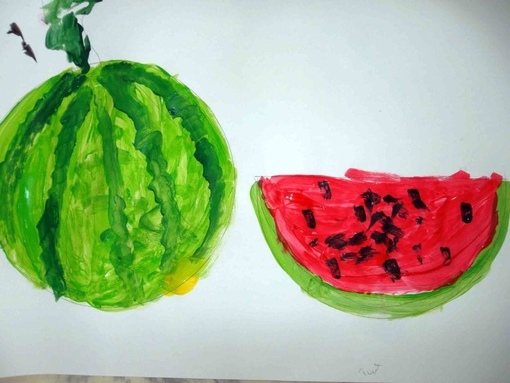
Children are curious to see how ordinary materials can be used for unusual purposes. So, let's get creative. We take the bag and start drawing our favorite fruits. The average kindergarten group may not understand why they were given cellophane instead of regular paper. Here the teacher must say that not all creative work is done on paper. Artists paint on canvas, fiberboard, etc. When the fruits are ready, we moisten clean sheets of paper in water and cover the cellophane masterpieces with them. The print can be detailed. For example, draw a twig and a leaf on an apple.
Plasticine drawing
Children have already realized that they can create not only with paints. So it’s time to conduct a lesson on drawing fruits in the middle group using plasticine. It is necessary to explain to children that plasticine is used not only by sculptors, but also by artists. It is most convenient to use a white disposable plate as a canvas. Using a pencil, the teacher or the children themselves draw the outline of the fruit. And then it remains a matter of little things.
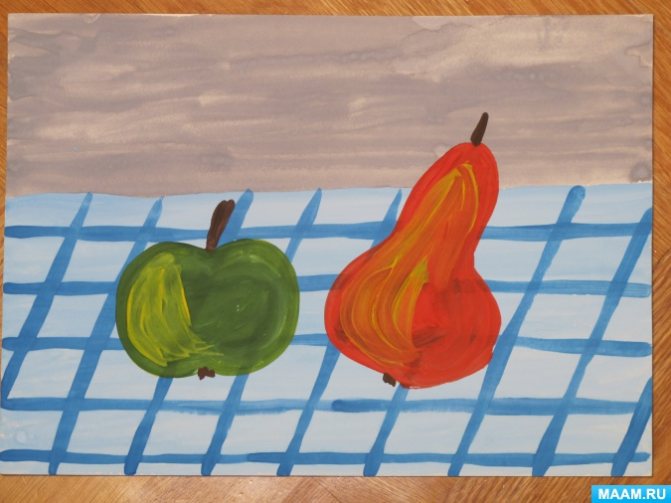
You need to fill the outline with small pieces of plasticine. You need to try to imitate a stroke. Children are unlikely to succeed the first time, but oh
Preview:
Drawing with paints on the topic: “Canning fruits.”
Goal: Continue to develop in children an idea of preparing food for the winter; With children, practice drawing round objects and painting over images. Fix colors: red, yellow, green.
Material: Silhouettes of cans of different sizes cut out of thick paper, gouache.
The teacher addresses the children:
- Guys, which of you forgot an apple here? Nobody? Well, maybe I left it here on the table myself.
At night, the toys came to life, scattered around the room, and the bear climbed onto the table and accidentally dropped an apple on the floor.
The hedgehog ran up, hung the apple on the needles and dragged it to his corner. He made a hole for himself there, just like a real hedgehog in the forest.
Doll Masha asks him:
- Why are you dragging the apple into the hole? You just eat it and that's it. Why hide?
— Compotes are sweet, they contain delicious berries: cherries, raspberries, and not just apples.
And he sighed again. He really wanted compote.
And all the toys became sad. They really wanted compotes, a variety of them: apples, plums, raisins, pears. Lots and lots in big jars so that everyone has enough for the winter.
Setting game and educational tasks:
Having discussed with the children the need to prepare compotes for toys, the teacher advises the children to fill the jars with apples. Then he invites the children to learn how to draw apples. Focus on the fact that apples can come in different colors and sizes.
Guidance on completing the task and subsequent game:
Before finishing work, the teacher asks the children where the compotes should be stored during the winter. After listening to the answers, he asks the toys whether they have a refrigerator or a cellar. Having learned that they have neither one nor the other, he invites the children to build some special room from building material (a cellar where all the jars of compotes could stand.
The children begin to build. For those who cannot cope with the task on their own, the teacher suggests that they can team up with a friend and work together. Helps children distribute responsibilities, giving each a feasible and interesting task.
Children can treat dolls and animals with compotes, organize a game store, etc.
The teacher conducts conversations with children who are no longer interested in the game. He asks the child what fruits or berries he canned for toys, what compotes he tried himself and which ones he likes best. You can ask questions about where the child’s family gets their compotes from (do they buy it in a store or make it themselves, does he help adults prepare it?
Source
More ideas for decorating with fruit themes
About two years ago I found an amazing retro fruit print at a Flatstock poster show in Austin, Texas.

I didn't know where I would put it, but I knew I needed it. Then I came home and decided that the only place for fruit art was in the kitchen, and since there was no room for it on the walls of my cooking space, the print had to be kept in my art drawer for the time being. be. Last week I came across the photo below of a child's room decorated with fruit:
[by Azevedo Design Inc.] Contemporary Fruit Nursery
Not that I needed permission to bring fruity interior design into other parts of the house, but this gorgeous interior has reignited my passion for fruit motifs and given me the go-ahead to hang my adorable print purchase wherever I please! Following on from our recent post on decorating with fruit, today we're exploring three ways fruit themes can make a statement in your home. And why they shouldn't just be limited to the kitchen...
Fruits on display
Okay, let's start with the obvious.

Real fruits can be placed in your home as a decoration for a room, table or surface.
Yes, it's that simple! After all, you're probably eating fruit. Why hide it in the pantry or refrigerator? Below we see a hanging basket filled with gifts from nature .
[from Soorikian Architecture] Hanging Fruit Basket Don't forget that fruit is the perfect way to add color to a neutral space . Grey, taupe, black and white may be the signature colors of this kitchen, but somehow the room doesn't come alive without a two-story wire baskets of oranges and lemons that sit on the kitchen island. [by Artdecor Interior Designers & Decorators]
Fruits at the center of the modern kitchen
A bowl of fruit works wonders. But don't be afraid to find unconventional ways to showcase your products . In the next image we see a long and narrow assortment of produce such as oranges, lemons and tomatoes.
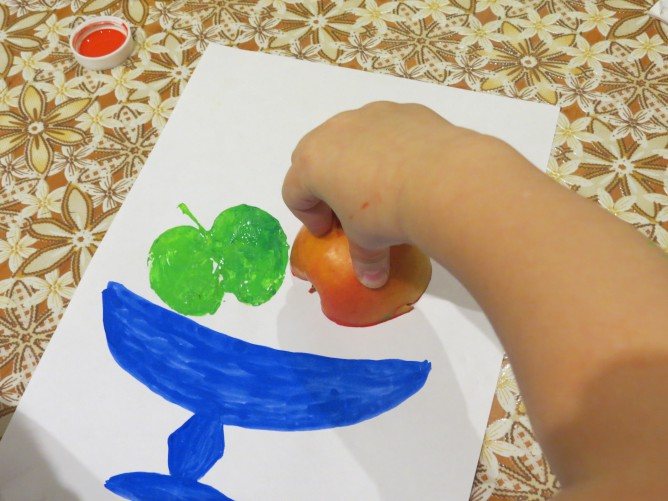
Notice how the shape and bright red color of the stand continues the modern tone set by this modern kitchen. [by Blount Design] Products in the modern kitchen
Who doesn't love a glass jar filled with delicious fruit ? This decorative element is a key feature of bistro kitchens like the one shown below. [by Peter Zimmerman Architecture]
Canisters of fruit in a bistro style kitchen
We know the holidays are still a long way off, but who doesn't love a little Christmas in July? There is nothing more festive than a large selection of fruits and other products. In fact, this approach can be applied to any holiday or season, including summer. Fill a long tray with groups of fruits, such as citrus fruits. will create a tropical flavor! [from Regina Gust]
Christmas decorations with fruity notes
Even if a fruit display isn't the centerpiece of the room, it can still be the centerpiece of your shelf or countertop.
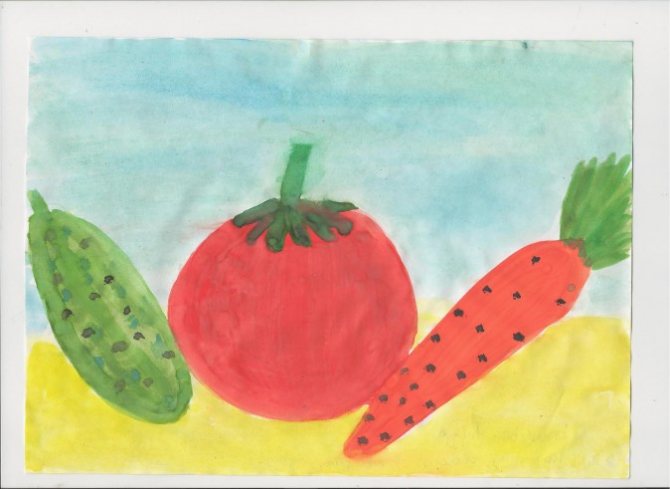
On the topic: methodological developments, presentations and notes
in this educational field of Artistic creativity, section: Drawing, non-traditional drawing technology and information technology are used.
Goal: To enrich children's ideas about winter nature through music, painting, poetry. Objectives: To clarify and expand children's knowledge about the characteristic signs of winter; introduce the new method shown.
Methodological development of direct educational activities using non-traditional drawing techniques in the junior group for the implementation of the educational field “Artistic and Aesthetic.
Summary of direct educational activities using non-traditional drawing techniques. Topic: “My hand is my family.”
Source
